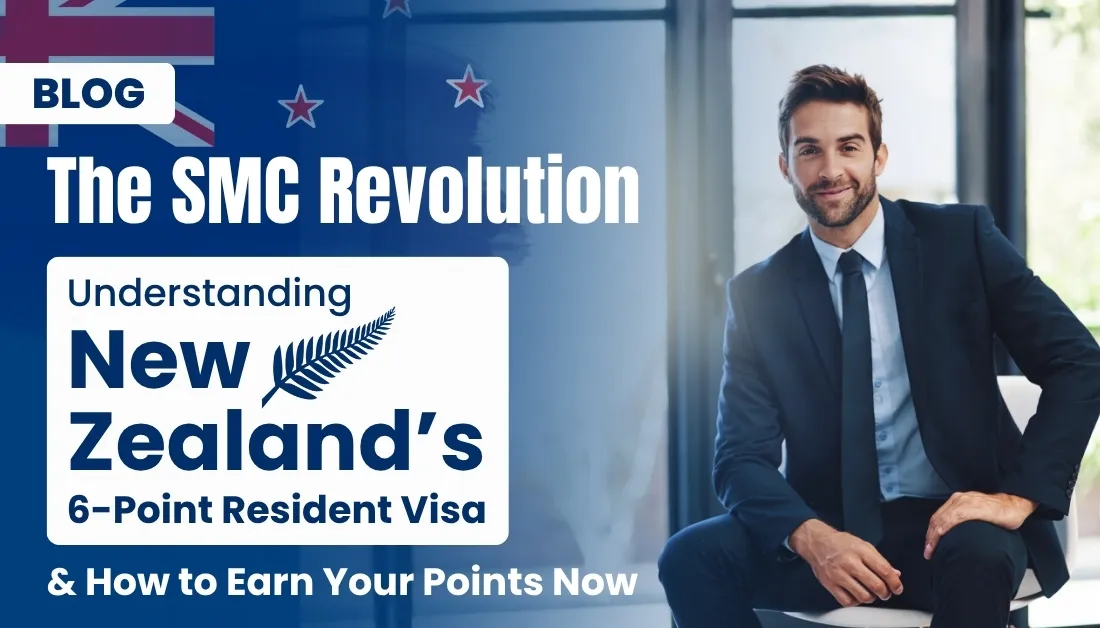October 13, 2025
If you can reach 6 skilled-resident points, hold (or have an offer for) a skilled job, and meet health/character/English requirements, you’re in the game for the Skilled Migrant Category (SMC) Resident Visa. Points come from one of three skill pillars — qualification, occupational registration, or income — and you can top up with NZ skilled work experience (up to +3) if needed.
No, you don’t have to work in NZ first if you already have the 6 points. You can apply now (subject to the other requirements, like having a skilled job offer).
How the current 6-point system works
- Choose your main pillar (one only):
Qualification or NZ occupational registration or income. Each can give 3–6 points depending on level.
- Top up with NZ skilled work experience:
Add up to 3 points for time in skilled work in New Zealand to reach the 6-point threshold.
- Income route
Higher pay bands earn more points; the top band is 3× median wage = 6 points. Check INZ’s pay-rate guidance before you plan.
- You still need the basics:
Skilled employment (or a skilled job offer), be 55 or younger, plus health/character/English.
How to earn points now (practical routes)
Qualification route
- Map your highest degree and confirm level/recognition (NZ or overseas).
- If overseas, plan for NZQA comparability where needed so your points are actually recognised.
- Build a clean evidence pack (certificates, transcripts, official letters).
(Points for qualifications sit within the 3–6 band; check your exact level/recognition before you rely on it.)
Occupational registration route
- If your occupation requires NZ registration or practising certificates, this can be your single, strongest pillar.
- Start early: some boards have multi-step processes or English/competency checks.
Income route (NZ Job)
- Use your current pay rate against INZ’s median-wage bands (evidence must match contracts, payslips, and tax records).
- Remember: the top band (3× median) yields 6 points; lower bands yield fewer points.
NZ skilled work experience (top-up)
- If your pillar gives you <6, add up to +3 for skilled NZ work experience.
- Keep the paper trail tight: contracts, payslips, IR filings, job descriptions that match skilled duties — not just job titles.
What’s changing from August 2026 (and why to plan now)
The Government has announced two additional SMC residence pathways to retain experienced workers — targeted launch August 2026. Expect:
- A Skilled Work Experience pathway (for skilled roles with set experience/wage criteria), and a Trades & Technician pathway (for specified trades/tech roles with defined qualification and NZ work components).
- Adjustments that recognise NZ university-level qualifications more and reduce some NZ work-experience requirements for certain pathways.
- Clarification that wage needs to be maintained through the required NZ experience period rather than re-tested at residence application.
Final operational settings will be published closer to go-live; use the time to get evidence-ready
Build an approval-grade evidence pack (what INZ actually checks)
- Duties vs. occupation: Map real duties to a skilled occupation; titles alone don’t win points.
- Pay proof: Contracts, payslips, and tax/IRD records must align with the wage band you claim.
- Qualifications/registration: Certificates, transcripts, board verifications, and (if needed) NZQA comparability.
- Work history: Start/end dates, referees, and letters on letterhead for any overseas experience you rely on.
(INZ’s public pages emphasise the pillars/points, pay-rate thresholds, and that NZ work experience points are “skilled” and evidence-based.)
Quick decision map
- Already at 6 points via one pillar?
Apply (assuming you meet job/offer + other requirements). You don’t have to wait to build NZ experience.
- Sitting at 3–5 points?
Plan a top-up: either increase income band, secure registration, or accumulate skilled NZ experience (+1 to +3).
- Eyeing 2026 pathways?
Use 2025–26 to gather proof (wage, duties, quals) and close gaps so you can move the day settings open.
Bottom line
The SMC 6-point system is designed to be clearer: one skill pillar does the heavy lift; NZ experience just tops you up. If you plan your route (and evidence) now, the 2026 settings should expand, not limit, your options — but only if your documentation is audit-ready.
Disclaimer: General information only — not immigration advice. For tailored advice, you must engage a Licensed Immigration Adviser under a written agreement.
Author Details
(LIA 201400900)
Director
Vandana Rai is a Senior Licensed Immigration Adviser and has built a reputation around her rare set of skills, which could be considered ideal for her legal profession.


